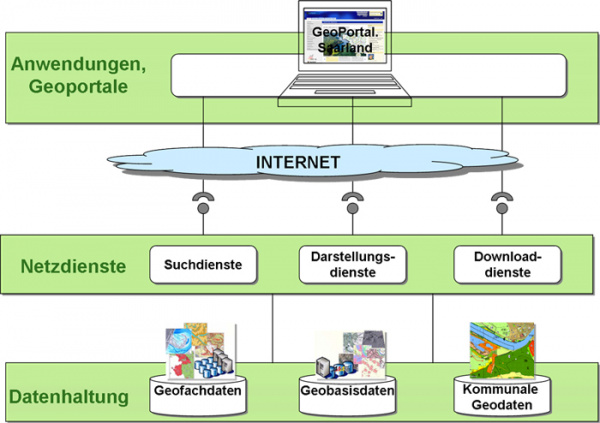Das-Geoportal/en: Unterschied zwischen den Versionen
Tschug (Diskussion | Beiträge) |
Tschug (Diskussion | Beiträge) |
||
| Zeile 10: | Zeile 10: | ||
<p>As the EU INSPIRE Directive requires Member States to guarantee access to their spatial data (services), Saarland’s Spatial Data Infrastructure Act (SGDIG 2009, section 8) tasks the State Office for Surveying, Spatial Information and Land Development (LVGL) with establishing a central access point for users. Accordingly, the Geoportal is responsible for enabling targeted access to shared mapping and data services, and ensuring that these can be usefully combined with one another. In this context, metadata and catalogue services form an indispensable part of spatial data, service and application discovery within a spatial data infrastructure: without their appropriate provision, information about the available services and data can neither be researched nor effectively accessed.</p> |
<p>As the EU INSPIRE Directive requires Member States to guarantee access to their spatial data (services), Saarland’s Spatial Data Infrastructure Act (SGDIG 2009, section 8) tasks the State Office for Surveying, Spatial Information and Land Development (LVGL) with establishing a central access point for users. Accordingly, the Geoportal is responsible for enabling targeted access to shared mapping and data services, and ensuring that these can be usefully combined with one another. In this context, metadata and catalogue services form an indispensable part of spatial data, service and application discovery within a spatial data infrastructure: without their appropriate provision, information about the available services and data can neither be researched nor effectively accessed.</p> |
||
| + | <p>The spatial data on the platform is usable 24 hours a day and without waiting times, both for specialist public administration and business users as well as ordinary citizens, helping them to stay well-informed about the many decisions needing to be clarified in both a personal and professional capacity. The number of records held and the range of applications on offer have both increased since the portal was created. Currently, the Portal has over 5,000 map layers and over 40 thematic applications on offer (including standard land values, protected area registries, noise pollution mapping, flood hazard maps, wind power atlases, forestry/agriculture, soil and geology, spatial planning, transport, etc.). By uploading their legally binding zoning plans, many municipalities in Saarland have also significantly expanded the online services they provide to their citizens.</p> |
||
| − | <p>Für die Fachanwender in der öffentlichen Verwaltung und in der Wirtschaft aber auch für Bürgerinnen und Bürger werden ganztags und ohne Wartezeiten die eingestellten Geodaten des Landes nutzbar sein, so dass vielfältige Entscheidungen im privaten und professionellen Umfeld besser vorbereitet werden können. Seit der Implementierung des Portals sind die Anzahl der Datensätze und das Angebot an Anwendungen stetig gestiegen. Derzeit werden bereits mehr als 5000 Kartenebenen und über 40 thematische Anwendungen im GeoPortal präsentiert (u. a. Bodenrichtwerte, Schutzgebietskataster, Lärmkartierung, Hochwassergefahrenkarten, Windenergieatlas, Forst- und Landwirtschaft, Geologie und Boden, Raumordnung, Verkehr usw.). Mit dem Einstellen der rechtsverbindlichen Bebauungspläne haben auch viele saarländische Kommunen ihr Internet-Angebot zum Bürger*innenservice deutlich erweitert.</p> |
||
<p>Das im Rahmen der Entwicklergemeinschaft aus den GDI-Koordinierungsstellen Rheinland-Pfalz, Saarland und Hessen entwickelte System basiert komplett auf Freier Open Source Software und wird seit dem kontinuierlich erweitert, modernisiert und optimiert.</p> |
<p>Das im Rahmen der Entwicklergemeinschaft aus den GDI-Koordinierungsstellen Rheinland-Pfalz, Saarland und Hessen entwickelte System basiert komplett auf Freier Open Source Software und wird seit dem kontinuierlich erweitert, modernisiert und optimiert.</p> |
||
Version vom 18. Januar 2022, 11:16 Uhr
GeoPortal SL
Within Saarland’s spatial data infrastructure (SDI), GeoPortal SL is assigned the task of providing spatial data at a state and municipal level. GeoPortal SL uses electronic networks to provide access to this spatial data.
GeoPortal SL went online in 2010; the portal was subsequently relaunched on 29 June 2020.
Geoportal Saarland acts as the main intermediary platform serving users and providers of spatial data in Saarland. As this core component, the portal gives citizens, policymakers, businesses and public administrators a straightforward means to research and visualise geo basic and geo specialist types of spatial data as provided by state and local governments. The portal also offers general information on the topics of spatial data and spatial data infrastructure.
As the EU INSPIRE Directive requires Member States to guarantee access to their spatial data (services), Saarland’s Spatial Data Infrastructure Act (SGDIG 2009, section 8) tasks the State Office for Surveying, Spatial Information and Land Development (LVGL) with establishing a central access point for users. Accordingly, the Geoportal is responsible for enabling targeted access to shared mapping and data services, and ensuring that these can be usefully combined with one another. In this context, metadata and catalogue services form an indispensable part of spatial data, service and application discovery within a spatial data infrastructure: without their appropriate provision, information about the available services and data can neither be researched nor effectively accessed.
The spatial data on the platform is usable 24 hours a day and without waiting times, both for specialist public administration and business users as well as ordinary citizens, helping them to stay well-informed about the many decisions needing to be clarified in both a personal and professional capacity. The number of records held and the range of applications on offer have both increased since the portal was created. Currently, the Portal has over 5,000 map layers and over 40 thematic applications on offer (including standard land values, protected area registries, noise pollution mapping, flood hazard maps, wind power atlases, forestry/agriculture, soil and geology, spatial planning, transport, etc.). By uploading their legally binding zoning plans, many municipalities in Saarland have also significantly expanded the online services they provide to their citizens.
Das im Rahmen der Entwicklergemeinschaft aus den GDI-Koordinierungsstellen Rheinland-Pfalz, Saarland und Hessen entwickelte System basiert komplett auf Freier Open Source Software und wird seit dem kontinuierlich erweitert, modernisiert und optimiert.
